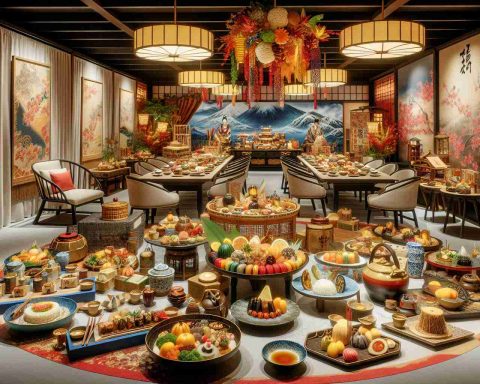- Michi-no-Eki Joso in Ibaraki Prefecture, Japan, offers a unique culinary experience from February 13 to March 26, 2025.
- Tokyo University of Agriculture students collaborate with local farmers to create innovative dishes.
- The menu includes a seafood rice bowl, “Inaho’s Oyako Don,” featuring salmon, ikura, and Tsukuba chicken.
- “Tororo Nikudofu Inaho Set” offers tender rose pork with local natto and fresh tofu.
- “Inaho Ebi-Furo Ramen” presents shrimp in a thick miso broth with noodles from Ibaraki wheat.
- This venue showcases Ibaraki’s finest produce, blending tradition and modern culinary techniques.
- Michi-no-Eki Joso redefines the rural Japanese dining experience through youthful creativity.
Nestled along the scenic Route 294 in Ibaraki Prefecture, Japan’s newest culinary destination, Michi-no-Eki Joso, crafts a gourmet experience like no other. Here, the collaboration between Tokyo University of Agriculture students and local farmers weaves a tantalizing tale of tradition and innovation. From February 13 to March 26, 2025, visitors can dive into a trio of exclusive dishes at the inviting Inaho Dining Hall—a celebration of Joso’s rural bounty and the creativity of budding chefs.
Imagine the vibrancy of a seafood rice bowl, “Inaho’s Oyako Don,” brimming with silky salmon and ikura, paired seamlessly with Tsukuba chicken. Each bite bursts with layers of flavor: the rich umami of sashimi soy blending with nutty sesame. Or indulge in the “Tororo Nikudofu Inaho Set,” comforting you with tender rose pork simmered to sweet perfection. This hearty dish is accompanied by local natto and fresh tofu, offering a myriad of tastes and textures.
For those daring enough to explore new horizons, “Inaho Ebi-Furo Ramen” delivers an extravagant affair. Picture shrimp gracefully dancing in a thick miso broth, enhanced by silky noodles crafted from Ibaraki’s prized wheat. As the flavors envelop your senses, complete the symphony with a final comforting scoop of rice to soak up every last savory drop.
Michi-no-Eki Joso isn’t just a stopover. It’s a true culinary theme park, bearing Ibaraki’s finest produce and masterfully engineered dishes that invite you to relish each moment. Here, local tradition renews itself at the hands of aspiring youth, proving that even amidst modernity, the heart of rural Japan beats a little stronger. Visit for an unforgettable feast that tells a story as rich as the land itself.
Experience Japan’s Rural Gastronomy Fusion: A Peek into Michi-no-Eki Joso
An Culinary Journey Blending Tradition and Modern Innovation
Michi-no-Eki Joso, nestled in Japan’s picturesque Ibaraki Prefecture along Route 294, offers more than just a pit stop with its enticing culinary experiences. Spearheaded by a collaboration between Tokyo University of Agriculture students and local farmers, this venture is a testament to the fusion of tradition and innovation. Held from February 13 to March 26, 2025, the event promises visitors an exploration of unique flavors at the Inaho Dining Hall through a selection of exclusive dishes.
# The Dishes that Define Michi-no-Eki Joso
1. Inaho’s Oyako Don: This seafood rice bowl is a vibrant medley featuring silky salmon, ikura, and Tsukuba chicken, all harmonized with sashimi soy and nutty sesame. The dish creates a multifaceted experience bursting with umami.
2. Tororo Nikudofu Inaho Set: A comforting arrangement of tender rose pork simmered to sweet perfection. Accompanied by local natto and fresh tofu, this dish delivers a diverse range of tastes and textures sure to satisfy.
3. Inaho Ebi-Furo Ramen: For the adventurous, this extravagant dish indulges with shrimp in a thick miso broth, enhanced by noodles made from Ibaraki’s finest wheat. A final scoop of rice completes this flavorful journey.
The Broader Impact on Communities and Future Prospects
# Enriching Local Economies through Gastronomy
– Economic Benefits: Michi-no-Eki Joso plays a pivotal role in supporting local economies. By sourcing produce directly from Ibaraki’s farmers, the initiative boosts the agricultural sector, fostering economic resilience.
– Tourism and Cultural Exchange: The destination is poised to attract tourists domestically and internationally, providing opportunities for cultural exchange and regional promotion.
# How does this concept affect global culinary trends?
Collaborations like Michi-no-Eki Joso are propelling the notion of culinary tourism globally, where travelers seek immersive food experiences that go beyond mere consumption. This shift promotes sustainability and revives forgotten traditions, making it a valuable precedent for other countries looking to blend gastronomy with tourism.
Related Domains for Further Reading
– Japan Travel: Dive deeper into the country’s stunning destinations and unique cuisine.
– Tokyo University of Agriculture and Technology: Explore collaborations between academia and agriculture for innovation in food production.
Michi-no-Eki Joso embodies more than just culinary delicacies; it is a narrative of community unity, regional pride, and forward-thinking in food innovation. As such ventures gain momentum, they not only change local landscapes but also pave the way for a brighter and more interconnected world food economy.









